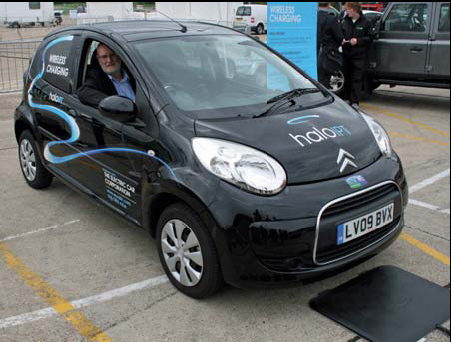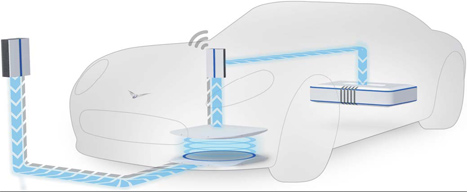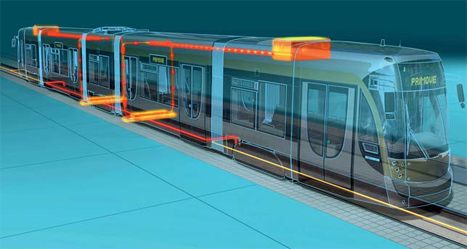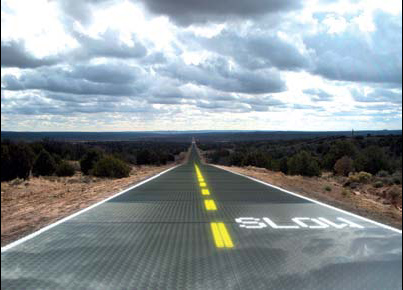Whether your car runs on petrol, LNG, diesel or electricity, using it is a constant cycle of fuel, consume, refuel. You have to keep your eye on the gauge that tells you how full your tank is (or, in electric versions, how your battery is doing) and make sure you’re in range of a petrol station (or charging point) when the indicators edge close to empty. And while most drivers develop a sense for how far they can push the limit and start getting antsy somewhere between a quarter and an eighth of a tank, the issue of range anxiety is still seen as a stumbling block in the development of electric cars.

But what if you never had to worry about recharging? If you never had to consciously take any action to make sure that your car had enough power on board; if you could be certain every time you settled into the driver’s seat that your car had enough energy to take you wherever you wanted to go, and you wouldn’t have to stop on the way?
In all fairness, this isn’t likely to happen any time in the near future. But the first step to what might be called the ’self-powering car’ is now being taken, with public transport leading the way. This step is the introduction of wireless charging for electric vehicles, and the pioneer in this sector is HaloIPT (IPT stands for inductive power transfer), a transportation R&D company whose roots are in New Zealand.
Wireless charging uses electric induction, which has been known for almost as long as electric current itself. A stream of electrons moving along a conductor generates a magnetic field around itself, which moves at the same pace. In the 18th century, Michael Faraday discovered that if he placed another conductor within that field, the magnetic force pulled the electrons in the second conductor along, generating another electric current. The closer the conductors, the more strongly the induced current will flow, although it will never flow as strongly as it does in the original conductor.
Induction underpins everything to do with electricity. Power stations use it in their generators, spinning permanent magnets inside a coil to transform the motion of a turbine into electric current. Transformers use it, with the current flowing in one coil inducing a current in a second, the ratio of turns in each coil dictating how much the original current is stepped down. You might well use it in your bathroom if you have an electric toothbrush - the battery in the toothbrush handle is charged up inductively from the base that’s plugged into the wall, so neither the brush nor the charger need to have exposed electrical terminals.
HaloIPT, a collaboration between Auckland-based R&D commercialisation company UniServices and engineering consultancy Arup, is extending this model to electric cars. The technology is analogous to an electric toothbrush, with the charging pad embedded in the ground and connected to the electricity grid, and the receiving grid housed within the floorpan of the car and connected to its battery. To charge the car, all you need to do is park it so that the receiver pad is over the charging pad. The practical advantage is obvious - you don’t have to plug the car in to charge it; you just have to park in the right place.


The system has three components: a high-frequency generator, which converts mains voltage of 240VAC at 50-60Hz into a high-frequency current at above 20kHz; the magnetic coupling, consisting of transmitter and receiver pads mounted in the ground and in the car respectively, which can be 100-300mm apart and do not need to be precisely aligned to work properly; and a pick-up controller, which converts the induced high-frequency current into a DC voltage of 250-400V to charge the car’s batteries. The variation allows the system to be battery agnostic; that is, it will work with batteries from any manufacturer, providing current in whatever conditions are specified to maximise the battery’s efficiency and lifetime. The efficiency of transmission is around 90 per cent.
With safety in mind, the pads contain sensors so that the charging pad only switches on when a receiver pad is in position above it. The driver specifies the rate of charge needed and the amount of electricity used is metered inside the car; payment would be via a tariff in much the same way as calls are charged on a mobile phone. The system works across the range of outdoor temperatures, from frigid winter to sweltering summer; under asphalt or concrete; and under ice, snow or even a layer of water.
Inductive charging technology is very well suited to public transport systems
Dick Stimpson, Arup/HaloIPT
’It will work in reverse as well,’ said Dick Stimpson, a veteran low-carbon vehicle specialist with Arup and HaloIPT’s technical programme leader. ’We can build intelligence into the system, so that parked cars are coupled into the grid and put electricity back into the network at times of high demand.’ Most cars are parked more than 90 per cent of the time; the concept of using stored battery power in parked electric cars is key to many smart-grid systems, and the energy ’sold back’ to the grid would be marked as a credit on the bill, ensuring that drivers only pay for the electricity they use in actually driving the car.
In fact, Stimpson explained, inductive charging has been used for around 10 years in Italy as part of public transport systems - around 40 buses in Turin and Genoa have been powered by inductive charging for 10 years, using a system provided by German energy transmission specialist Conductix Wampfler. ’Inductive charging is very well suited to public transport,’ he said. ’The vehicles have a guaranteed parking space every night so it’s easy to ensure that every space has a charging pad; the buses are just parked and charge up overnight. The feedback we have from that is that it’s a virtually maintenance-free system.’
According to Neil Butcher of Arup, project leader on the CABLED trial of electric cars to determine user experience, car manufacturers are enthusiastic about inductive charging. ’They see it as a feature they can offer for their higher-end vehicles. The idea would be that you’d buy the electric car equipped with the receiver pad, and the package would include a transmitter pad that would be installed in your driveway or garage. Several European car manufacturers are looking at this as part of their electric car programmes.’
But if inductive charging catches on in a big way - as HaloIPT hopes it will - then what happens if you don’t have a garage or a driveway? In that case, there would likely be a push towards having charging pads installed below the surface along roadsides. ’And that leads you on to another version of inductive charging technology,’ Stimpson said. ’If you had inductive charging along the middle of the road, you could charge while you drive on a powered highway.’
Car manufacturers see inductive charging as a feature they can offer for their higher-end vehicles
Neil Butcher, Arup
Technology such as this is also being used in public transport, where it is a natural development of the electric tram. Instead of the trams’ electric motors being powered by electricity picked up from overhead wires or electrified rails, they are powered by induction. Bombardier has developed a system called Primove, which uses induction lines buried below the road’s surface between the rails. The trains also incorporate regenerative braking, which charges up on-board capacitors. The company is aiming the system at historic town centres as it would enable the removal of unsightly overhead powerlines. It also has safety implications as all the current-carrying components are safely encapsulated under the road.

Extending such a system to work with private cars, rather than regulated trams, would not be a trivial project; the roadworks to install the infrastructure would no doubt be highly disruptive. However, Berlin-based automotive engineering developer IAV is among the organisations looking seriously at this option.
’It makes the road itself a range extender,’ said Wilfried Nietschke, head of IAV’s Technology Monitoring business division. Electric cars running on this system would still have batteries but charging would be done whenever a charging pad or a roadway system was available - making ’self-charging cars’ a technological possibility. Additional technology would, however, be required on the car; as the distance between charging and receiving pad is vital to reduce losses in the induction processes, the vehicle would need to be equipped with active suspension.
However, this would also allow one of the biggest advantages of range extenders to be incorporated into cars: the battery capacity would only need to be sufficient for the majority of journeys - around 60km; any further and the charging mechanisms would come into play to keep the battery topped up. This would reduce both the weight and cost of the cars.
Stimpson points out that electric cars are not, of themselves, a low-carbon solution. Unless the electricity itself is low carbon in origin, the emissions are not reduced, merely shifted from diverse sources to a single-point source. ’All this work really needs a shift to low-carbon generation,’ he said. However, with their convenience and safety advantages, the steps being taken in inductive charging are a glimpse into a convincing future for car travel and infrastructure design.
Solar roads: electric avenues
Powered highways incorporating solar panels could help make electric vehicles more practicalThe idea of powered highways might seem like a look into the distant future, but an idea being developed by US company Solar Roadways takes the concept of the electric road a stage even further. The brainchild of Scott Brusaw, an electrical engineer from Ohio, Solar Roadways is seeking - as the name implies - to develop roads that incorporate solar panels into their very structure.
Brusaw is working on a three-layer panel structure for the solar road. The top layer is a translucent glass, textured to provide traction in all weathers and toughened to withstand the weight of road traffic. Embedded within this are photovoltaic cells, along with a heating element to prevent the surface from icing up in the winter, and arrays of LEDs that can be configured to provide road markings. Below this is an electronics layer incorporating loadcells to keep track of traffic and control systems for the lighting and heating elements. The lowest layer contains the power and data distribution equipment for the roadway.

Brusaw has received funding from GE as a winner in its ’Ecomagination’ competition, and last year received a contract from the US Federal Highway Administration to build a prototype panel, which used polycarbonate in place of toughened glass to keep costs down.
It is part of Brusaw’s ambitious vision to incorporate electric vehicle charging into a solar road network. ’Imagine one major fast-food chain retrofitting its parking lots across the nation; electric vehicles could recharge in those parking lots when needed. This would make electric vehicles far more practical.’
The data system parameters for the HaloIPT installation
Input voltage 240VAC
Input supply Single phase
Output voltage 300VDC
Output power 5kW
Physical separation 220mm
Lateral tolerance 150mm off-centre
Efficiency >85 per cent
Power factor Near unity
Physical size 800 x 400 x 30mm




Project to investigate hybrid approach to titanium manufacturing
What is this a hybrid of? Superplastic forming tends to be performed slowly as otherwise the behaviour is the hot creep that typifies hot...